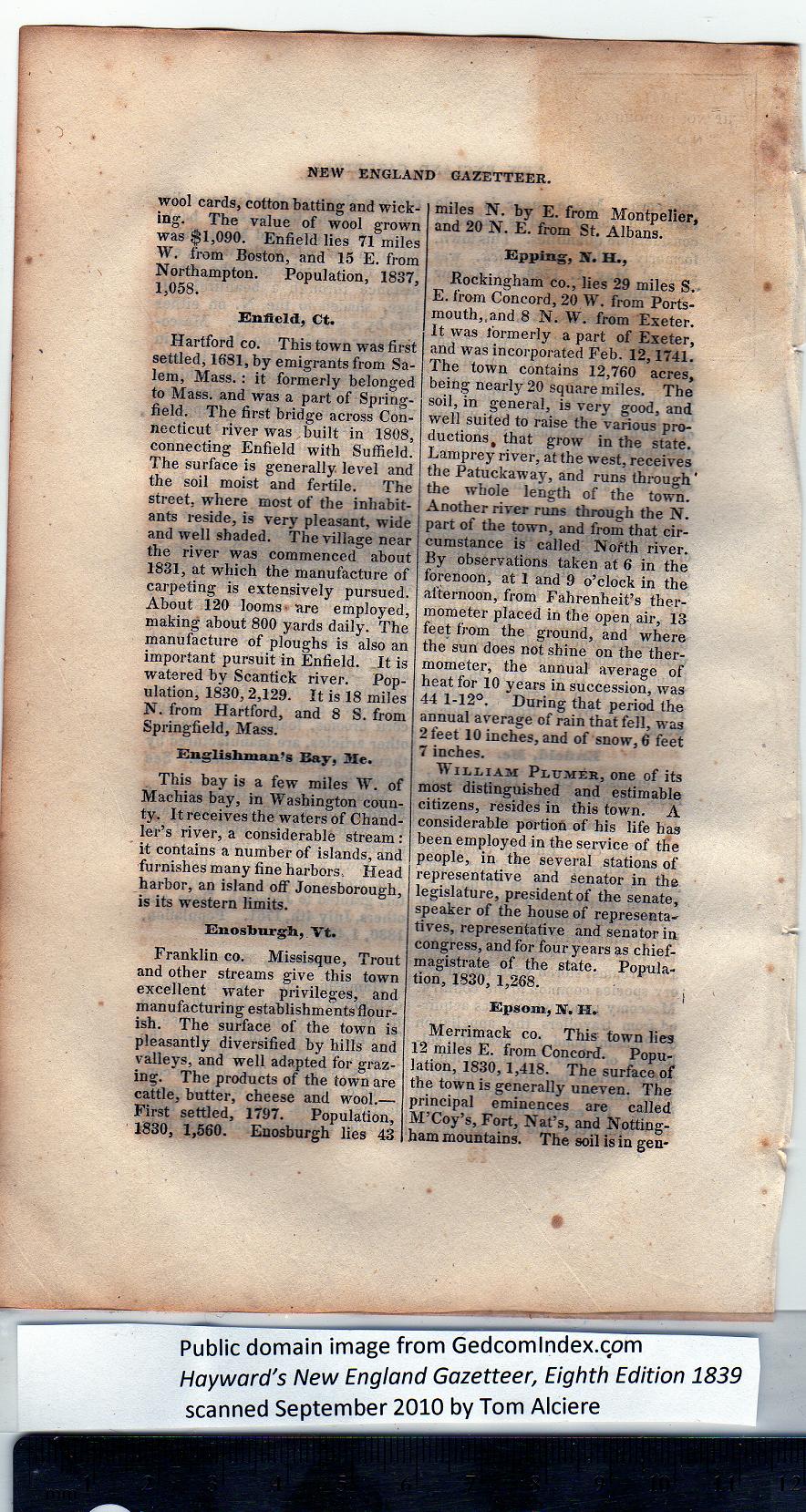|
wool cards, cotton batting and wick-
ing. The value of wool grown
was 01,090. Enfield lies 71 miles
W. from Boston, and 15 E. from
Northampton. Population, 1837,
1,058.
Enfield, Ct.
Hartford co. This town was first
settled, 1631, by emigrants from Sa-
lem, Mass.: it formerly belonged
to Mass. and was a part of Spring-
field. The first bridge across Con-
necticut river was built in 1808,
connecting Enfield with Suflield.
The surface is generally level and
the soil moist and fertile. The
street, where most of the inhabit-
ants reside, is very pleasant, wide J
and well shaded. The village near
the river was commenced about
1831, at which the manufacture of
carpeting is extensively pursued.
About 120 looms nre employed,
making about 800 yards daily. The
manufacture of ploughs is also an
important pursuit in Enfield. It is
watered by Scantick river. Pop-
ulation, 1830,2,129. It is 18 miles
N. from Hartford, and 8 S. from
Springfield, Mass.
Englishman’s Bay, Me.
This bay is a few miles V. of
Machias bay, in Washington coun-
ty. It receives the waters of Chand-
ler’s river, a considerable stream:
it contains a number of islands, and
furnishes many fine harbors s Head
harbor, an island off Jonesborough,
is its western limits.
Enoslburgh, Vt.
Franklin co. Missisque, Trout
and other streams give this town
excellent water privileges, and
manufacturing establishments flour-
ish. The surface of the town is
pleasantly diversified by hills and
valleys, and well adapted for graz-
ing. The products of the town are
cattle, butter, cheese and wool.—
First settled, 1797. Population,
1830, 1,560. Enosburgh lies 43 |
miles N. by E. from Montpelier,
and 20 N. E. from St. Albans.
Epping, X. H.,
Rockingham co., lies 29 miles S.
E. from Concord, 20 W. from Ports-
mouth,,and 8 N. W. from Exeter.
It was formerly a part of Exeter,
and was incorporated Feb. 12,1741.
The town contains 12,760 acres,
being nearly 20 square miles. The
soil, in general, is very good, and
well suited to raise the various pro-
ductions # that grow in the state.
Lamprey river, at the west, receives
the Patuckaway, and runs through
the whole length of the town.
Another river runs through the N.
part of the town, and from that cir-
cumstance is called North river.
By observations taken at 6 in the
forenoon, at 1 and 9 o’clock in the
afternoon, from Fahrenheit’s ther-
mometer placed in the open air, 13
feet from the ground, and where
the sun does not shine on the ther-
mometer, the annual average of
heat for 10 years in succession, was
44 1-12°. During that period the
annual average of rain that fell, was
2 feet 10 inches, and of snow, 6 feet
7 inches.
William Pltjmer, one of its
most distinguished and estimable
citizens, resides in this town. A
considerable portion of his life has
been employed in the service of the
people, in the several stations of
representative and senator in the
legislature, president of the senate,
speaker of the house of representa--
tives, representative and senator in
congress, and for four years as chief-
magistrate of the state. Popula-
tion, 1830, 1,268.
Epsom, ]V. H.
Merrimack co. This town lies
12 miles E. from Concord. Popu-
lation, 1830,1,418. The surface of
the town is generally uneven. The
principal eminences are called
M’Coy’s, Fort, Nat’s, and Notting-
ham mountains. The soil is in gen- |
